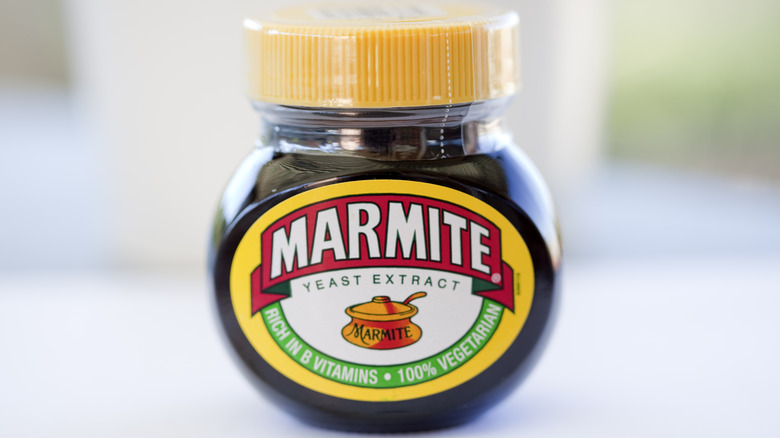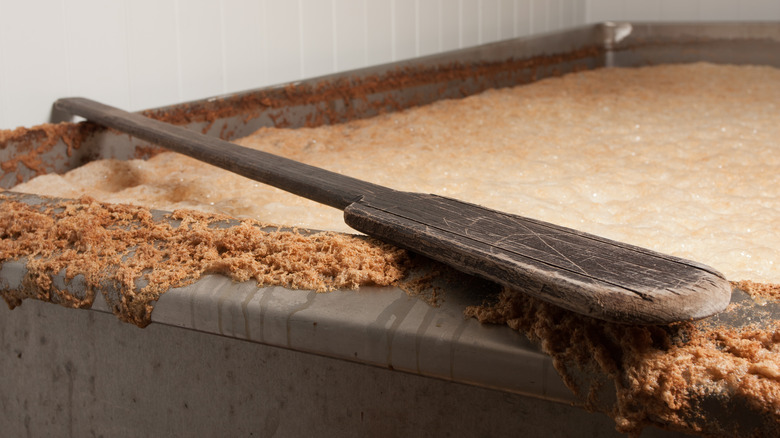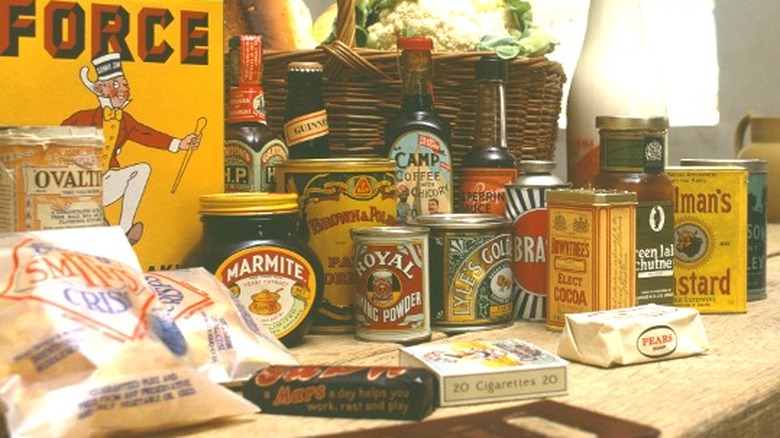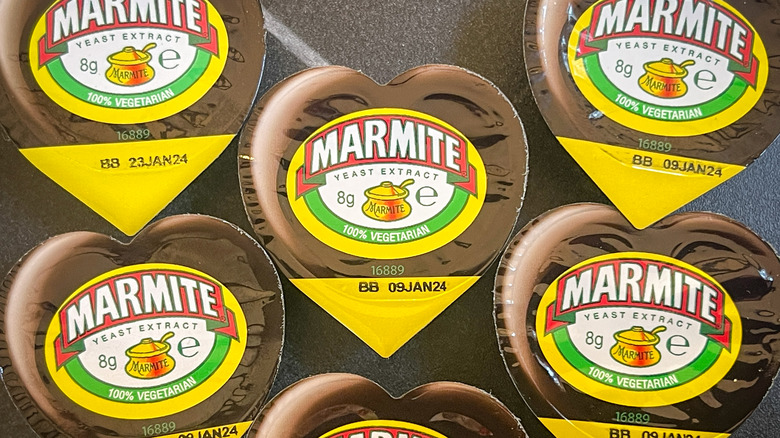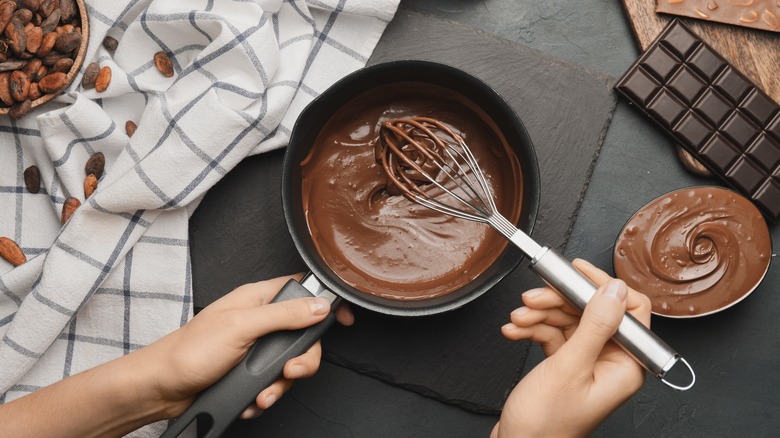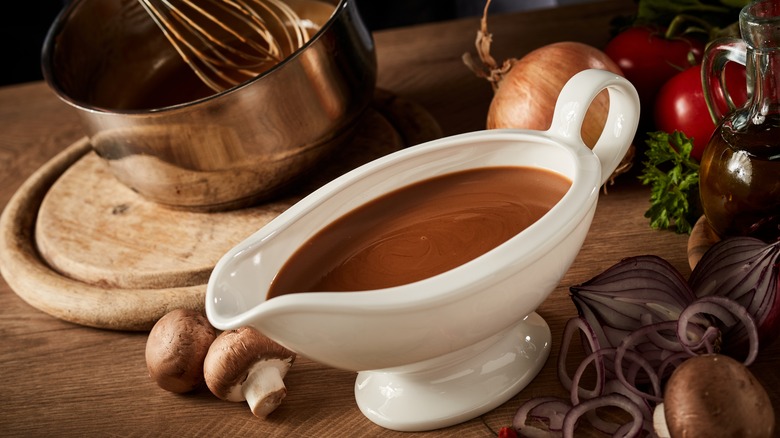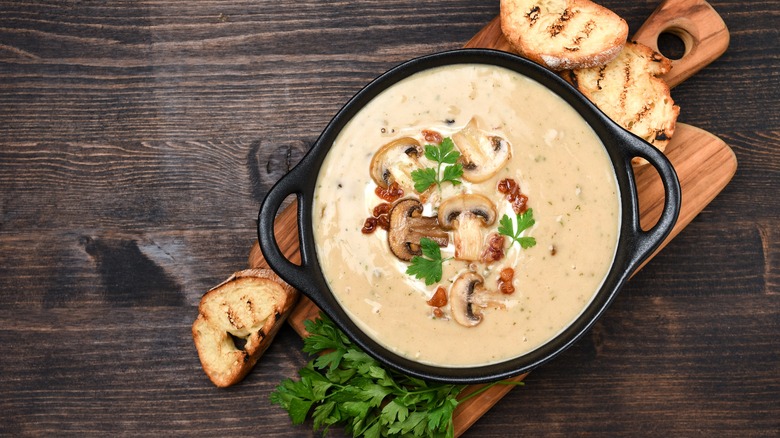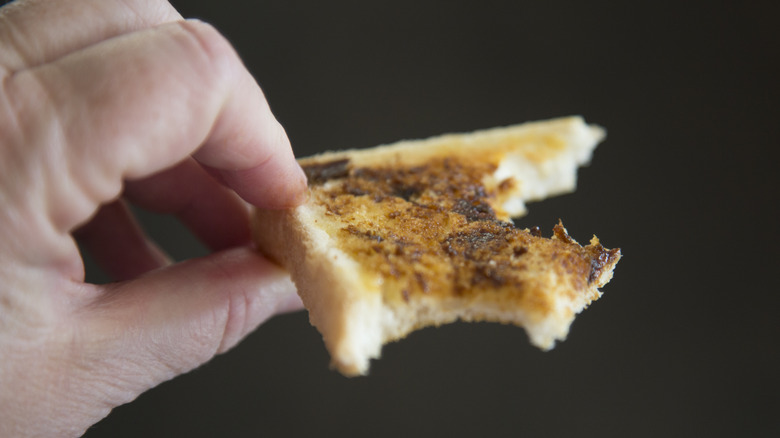The Ultimate Guide To Using Marmite
It's dark, it's thick, and its intensity divides people's opinions like no other food. Beloved by some and despised by others, Marmite is a unique product that's a staple in the British Isles. It's also inspired similar products in Australia and New Zealand. However, it's a bit of an oddity elsewhere in the world. For fans of the spread everywhere, though, it's a kitchen table necessity.
Marmite is something of a contradiction. It's a simple substance — primarily, it consists of concentrated yeast. Yet its flavor is incredibly complex and hard to define. Deeply savory, tangy, and salty, it's an incredibly versatile item that can be enjoyed as a simple dip or spread, or added to all kinds of recipes. Marmite has that indescribable umami taste, which adds intensity and enhances flavors. Whether you start every morning with Marmite on toast, or you haven't yet had a chance to try it yet, read on to learn more about this fascinating food, from its intriguing history to unique ways to incorporate it into your cooking.
It's made from yeast
You may be wondering what exactly Marmite consists of. It's labeled as "yeast extract," but what does that mean? How does yeast become a thick, dark spreadable substance? Believe it or not, it all starts with beer.
To make beer, brewer's yeast is used to create alcohol by fermenting sugars present in malted grain. After the fermentation is complete, there is yeast left over which is no longer needed for beer production. These spent yeast cells can then be heated until they break down, then reheated further until they concentrate into the familiar paste-like consistency. To become Marmite, other ingredients are added for extra flavor, including salt and vegetable concentrate, as well as vitamins to boost its nutritional content. Thus, Marmite is made.
Other versions of Marmite — like Australia's Vegemite or the New Zealand version of Marmite — are made using the same process. But these products have slightly different recipes that differentiate them.
The condiment has a fascinating history
Marmite was first produced commercially in 1902. But the substance was invented in the previous century by a German scientist named Justus Freiherr Von Liebig. Despite its German origins, England is the country most associated with the product. The original Marmite factory was smartly located in Burton on Trent, an English town also home to the iconic Bass brewery, making it easy for the company to access yeast. Marmite was an instant hit. Its popularity grew over the decades. It was even given to soldiers in both World Wars as a healthy supplement with their rations.
The container for Marmite has evolved throughout its history. The substance was initially housed in a ceramic jar, but glass became the vessel of choice after 1920. The same round containers are used today. The darkened glass matches the brown color of the Marmite inside, but it's also practical: it helps protect the substance from light, which can diminish its nutritional value.
In 2000, Marmite was acquired by British company Unilever. There is now a range of other Marmite products that come in unique flavors like truffle and chili. There is even Marmite peanut butter.
It contains beneficial nutrients
Even if you're not crazy about the taste, you may want to consider adding Marmite to your diet, purely for its health benefits. According to The Independent, it's packed with B vitamins including thiamine, riboflavin, and niacin — all of which contribute to eye and skin health. Studies suggest that thiamine (B1) may positively affect heart health. Vitamin B3 (niacin) improves oxygen flow in your cardiovascular system. B vitamins can also help you feel less depleted after a night of drinking, so keeping Marmite around to take the edge off of a hangover isn't a bad idea.
It's also got B12, which is good for your brain. In fact, a University of York study found that regular Marmite consumption led to increased levels of GABA, a neurotransmitter that regulates brain activity. Marmite also contains magnesium. According to Healthline, this nutrient helps regulate important things like sleep, mood, and blood sugar.
The only red flag — when it comes to health — is Marmite's salt content. If you're sensitive to high levels of sodium, you'll want to keep an eye on your intake (via WebMD).
The ingredient does wonders for plant-based cooking
With veganism and vegetarianism becoming more mainstream than ever, more people are embracing plant-based eating, whether for moral or health reasons. If you're a staunch vegan or part-time flexitarian, you should consider adding Marmite to your culinary pursuits. Unlike similar umami-laden substances like fish sauce or Worcestershire, it's suitable for vegans and is a super easy way to boost the flavor of all kinds of recipes.
If you're struggling to create flavorful plant-based dishes, Marmite may be the secret ingredient you're looking for. A spoonful can be added to vegetable stock in order to add a meaty, savory dimension that plant-based stocks can often lack. However, you should be wary of reducing your liquid too much, as Marmite's salt content can lead to over-seasoning. You can also use Marmite as a substitute for anchovies or sardines when looking to make recipes vegan and vegetarian-friendly.
Aside from adding flavor, there's an extra health benefit for plant-based eaters. According to a study published in the National Library of Medicine, vegetarians and vegans are likely to develop a vitamin B12 deficiency, since this nutrient is most commonly found in animal products. Marmite is a good alternative source of this vitamin.
There's a difference between Marmite and Vegemite
Marmite's success in the United Kingdom didn't stay within its borders forever. Australia, in particular, developed a love for the stuff, inspiring a local Aussie to create his own version. About 20 years after Marmite was first produced, Vegemite made its debut. It was originally labeled as "pure vegetable extract," in an effort to differentiate it from Marmite's "yeast extract" description. However, the main ingredient, concentrated brewer's yeast, was the same. Vegemite also contains vegetable extract and salt, similar to Marmite, and boasts B vitamin content. But vitamin B12 is notably absent, although it is present in the low-salt version (via Delicious).
On the surface, Vegemite and Marmite seem like identical products. But despite their similar ingredients and packaging resemblances, there are some differences that become fairly obvious if you taste the two side by side. Their textures are distinct: Vegemite is much thicker and denser, while Marmite has a more syrup-like consistency. Marmite is also slightly lighter in color. They taste quite similar to one another, with the same rich, yeasty, umami flavors. Some say Vegemite is the more potent of the two, and has a bitter taste, while others claim Marmite has more intensity.
To confuse things further, New Zealand has its own version of Marmite — which is also called Marmite. The country uses its own recipe, which is kept secret, and results in a slightly sweeter, more mild flavor than the other two yeast extract products.
Spreading it on toast is a classic application
While versatile Marmite has an endless list of uses, it's best known for its affinity with toast. A classic British way to start your day is with a few pieces of browned bread, slathered with lots of melty butter and a thin layer of Marmite. The rich creaminess of the butter helps to mellow out Marmite's sharp bite, toning down its intensity.
You can spread the two ingredients on as separate layers, or make your own Marmite butter. This way, the pair of ingredients are fully integrated and ready to grace your toast at any time. Simply combine softened butter and Marmite — how much is up to you, and your tolerance of the stuff — and whip them together using a hand or stand mixer. Whichever method you prefer, make sure to use unsalted butter when mixing it with Marmite. The inherent saltiness of the spread means your Marmite butter doesn't need any more seasoning.
Feel free to fancy up your toast with other toppings, too; ingredients with fat, like cheese or avocado, work just like butter to round out Marmite's harsh edges. Savory ingredients like mushrooms also match up well with the spread's flavors. Marmite makes a great addition to sandwiches, too, especially when mixed with other condiments like mayonnaise and mustard, or spread on the inside of bread for grilled cheese.
The condiment also goes great with chocolate
With its savory and rather pungent flavor, you might not immediately think of Marmite in combination with sweet-tasting foods like dessert. But through some strange mystical alchemy, its unique character melds well with chocolate. The two disparate ingredients, when properly utilized together, create a truly fascinating symphony of flavors that is a one-of-a-kind taste experience.
There's so much interest in this combination that an official Marmite-infused chocolate bar, called Very Peculiar, was released in 2010. While fans generally enjoyed it, some felt the Marmite was too subtle — it made up only 2% of the bar — and showed more in the aroma than the flavor. Famed English chocolatier Paul A. Young has utilized Marmite in several of his concoctions, including Marmite truffles and a Marmite XO-filled chocolate bar, both of which embrace the intensity of Marmite's flavor rather than trying to minimize it.
A lot of what makes these ingredients work well together is the salt component of Marmite, which makes the chocolate taste sweeter and less bitter. The next time you whip up a chocolate dessert, like brownies or truffles, add a touch of Marmite and see how it enhances the flavors.
You can drink it
Marmite's syrupy texture lets it mix well into liquids, whether hot or cold, so it's just as versatile an ingredient in drinks as it is with food. It's well suited for a number of drink styles, where its savory punch of flavor works to complement the rest of the beverage.
A dollop of Marmite added to a smoothie punches up the nutrition, adding its B vitamins and minerals into the mix. Flavor-wise, it matches up particularly well with smoothie ingredients like peanut butter, yogurt, and avocado, which have fats and creamy textures that mellow out its intensity. For a savory, warming drink, Marmite mixed with hot water creates a simple tea-like beverage, which you can then steep with other whole spices and herbs for more flavor.
Marmite can even be used in cocktails. It's right at home in drinks like a bloody Mary or chili-lime michelada, which already include salty and savory ingredients. For a dirty martini with a unique twist, add a touch of Marmite: take your gin or vodka, add a small amount of marmite, and then stir until it dissolves. Then continue making your dirty martini as usual. You'll get an incredibly deep, briny flavor.
This spread peps up sauces, dips, and dressings
Marmite can add an unbelievable level of flavor complexity to anything you can mix it into. If you find yourself with an underwhelming sauce, whisk a bit of it in and you'll be amazed at the transformation. This goes for condiments, dips, dressings, gravies, marinades — you name it.
For pan sauces, gravies, and any other type of sauce that needs to be reduced, be aware of salt content. If you're adding marmite, you probably don't need any additional salt. For meat sauces like turkey gravy or beef jus, marmite punches up the meatiness. It can also add succulence to vegetarian versions. It brings even more umami to mushroom sauces. If you're finding a cream-based sauce bland, a hit of marmite will take it to another level.
Marmite can take the place of anchovies in Caesar salad dressing if you're looking for a vegan alternative, adding its definitive briny umami character. Its flavor-enhancing superpower works just as well in creamy dressings as it does in vinaigrettes. Just about any dip can benefit from a spoonful or two of Marmite, from caramelized onion dip to roasted garlic hummus to queso. Don't be afraid to add some to store-bought dips and dressings, as well.
Stir it into soups and stews
Soups and stews are wonderful opportunities to utilize Marmite's flavor-boosting capabilities. Stir in a spoonful or two at the beginning of the cooking process to let the rich Marmite flavor slowly simmer with the rest of the ingredients, or add it at the end if you taste your soup or stew and find it needs depth and seasoning. Either way, it only takes a touch of Marmite magic to elevate these dishes to another level of flavor.
In soups that already boast a ton of umami flavor, like tomato and mushroom recipes, adding Marmite will greatly boost their savoriness. French onion soup is a great candidate for Marmite, too. If made from a classic recipe, with beef stock, the Marmite will make it taste even meatier. If you are making a vegetarian version, you'll hardly be able to tell the difference.
Any stew with beef or mushrooms will benefit from a little Marmite. This ingredient also complements root vegetables, contrasting with the natural sweetness of ingredients like carrots and parsnips. Marmite gives depth to chili, particularly if it's vegetarian. As always, keep tabs on the salt level, as Marmite's saltiness can intensify as the liquid reduces.
Toss pasta or potatoes with Marmite
If you've got Marmite and pasta in your pantry, you've got dinner. A super simple meal packed with flavor is noodles tossed with Marmite. For best results, stir the spread into butter or olive oil to let it coat the pasta. Parmesan cheese is another excellent addition, boosting the umami flavor from the Marmite and adding another dimension of richness. Marmite is also great when added to meaty sauces like bolognese, mushroom pasta dishes, and other Italian classics like carbonara. Stir some into the risotto, too.
Speaking of starch, Marmite is also a nice companion to potatoes. Whether you've got a pan of roasted potatoes, a skillet of hash browns, or a fryer full of French fries, give them a quick toss in Marmite to add deep seasoning. A dollop of Marmite mixed into mashed potatoes gives them a hearty, savory dimension. The next time you make twice-baked potatoes, add a tiny touch of Marmite to the cooked potato pulp before you add it back into the shell and you'll be amazed at how much extra flavor it imparts.
You can make your own at home
Despite the fact that Marmite seems like such an industrial product, you can actually make your own at home. It takes significant time and effort, but it can be a fun kitchen project. Plus, you'll better appreciate the origins of Marmite and what a unique and interesting substance it is.
All you need is bread, yeast, and sugar for the base. Mixing pieces of toast in water with sugar and yeast — either brewer's or baker's — will start the fermentation process. Then, this combination needs to be covered and left alone. After a few days of fermentation, you'll move to the stove. There, the liquid is heavily reduced until it's the right syrupy consistency. This can take hours, depending on how much water you started with.
You can add vegetable stock to try and emulate the commercial Marmite flavor or add your own flavoring elements to mix things up. Season it with salt if it needs it, and other spices if you like. It won't taste exactly like the store-bought version, but you may find your homemade Marmite is more to your taste, which can make it worth the effort.
